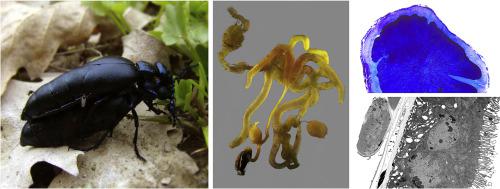Arthropod Structure & Development ( IF 2 ) Pub Date : 2020-08-20 , DOI: 10.1016/j.asd.2020.100980 Maurizio Muzzi 1 , Andrea Di Giulio 1 , Emiliano Mancini 2 , Emiliano Fratini 3 , Manuela Cervelli 3 , Tecla Gasperi 3 , Paolo Mariottini 3 , Tiziana Persichini 3 , Marco Alberto Bologna 3

|
Blister beetles owe their name to their ability to release cantharidin, a blistering terpene, the highest concentration of which is retained in male accessory glands. The anatomy and ultrastructure of the three pairs of male reproductive accessory glands and the glandular region of the two vasa deferentia of Meloe proscarabaeus were investigated using light, electron and ion beam microscopy. All of the mesodermal glands here analysed share a common structural organization with an outer muscular layer and an inner glandular epithelium facing a broad lumen in which the secretory products are released. Developed rough endoplasmic reticulum, Golgi systems, abundant mitochondria, numerous secretory vesicles and a microvillated apical membrane are commonly found in the cells of different glandular epithelia, suggesting that all accessory gland pairs as well as the vasa deferentia are involved in an active synthesis. Nevertheless, each pair of glands appears specialized in the production of a specific set of substances, as suggested by the peculiarities in cellular ultrastructure and by the different aspect of the secretions stored in their glandular lumen. The above cited features of male accessory glands of M. proscarabaeus are compared with those of other beetles and some hints on their potential role in producing and/or concentrating cantharidin are provided.
中文翻译:

硬泡甲虫Meloe proscarabaeus Linnaeus的雄性生殖附属腺,1758年(鞘翅目:Meloidae):斑th素储存器官的解剖学和超微结构。
起泡的甲虫之所以得名,是因为它们能够释放出cantharidin(一种起泡的萜烯),其最高浓度保留在雄性副腺中。三对雄性生殖附属腺和淡水pro的两个脉管输精管的腺体的解剖学和超微结构用光,电子和离子束显微镜检查。此处分析的所有中胚层腺共有一个共同的结构组织,其外部肌肉层和内部腺上皮面对着宽腔,分泌产物在其中释放。在不同的腺上皮细胞中通常发现发达的内质网,高尔基体系统,丰富的线粒体,大量的分泌性囊泡和微创的顶膜,这表明所有副腺以及输精管都存在参与了积极的合成。然而,正如细胞超微结构的特殊性和储存在其腺腔中的分泌物的不同方面所暗示的那样,每对腺体似乎专门生产一组特定的物质。将上述所提到的Proscarabaeus雄性附属腺的特征与其他甲虫的特征进行了比较,并提供了一些提示,说明它们在生产和/或浓缩邻苯二酚中的潜在作用。



























 京公网安备 11010802027423号
京公网安备 11010802027423号